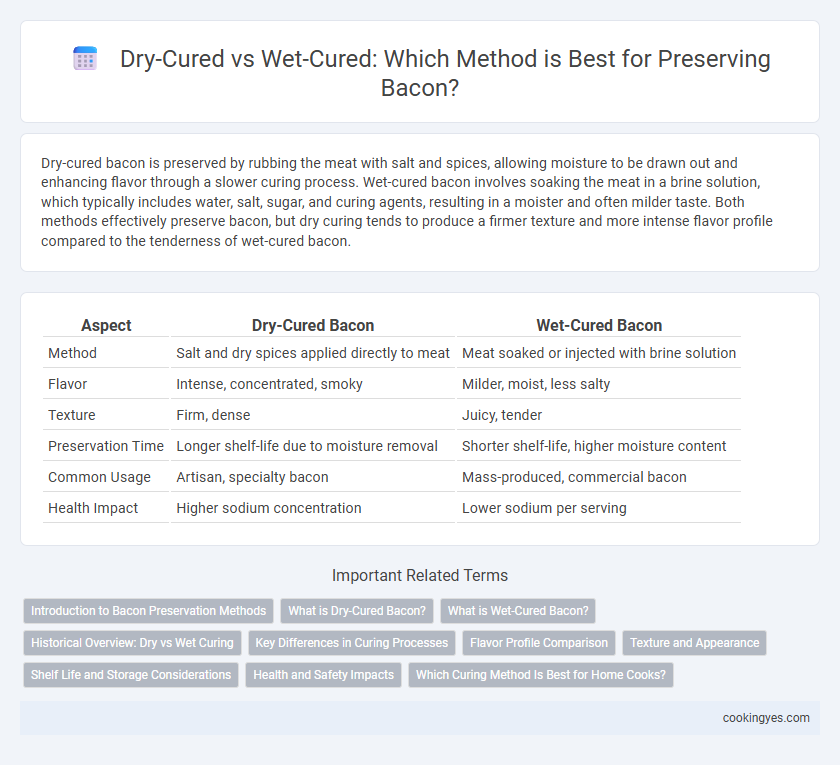Dry-cured bacon is preserved by rubbing the meat with salt and spices, allowing moisture to be drawn out and enhancing flavor through a slower curing process. Wet-cured bacon involves soaking the meat in a brine solution, which typically includes water, salt, sugar, and curing agents, resulting in a moister and often milder taste. Both methods effectively preserve bacon, but dry curing tends to produce a firmer texture and more intense flavor profile compared to the tenderness of wet-cured bacon.
Table of Comparison
| Aspect | Dry-Cured Bacon | Wet-Cured Bacon |
|---|---|---|
| Method | Salt and dry spices applied directly to meat | Meat soaked or injected with brine solution |
| Flavor | Intense, concentrated, smoky | Milder, moist, less salty |
| Texture | Firm, dense | Juicy, tender |
| Preservation Time | Longer shelf-life due to moisture removal | Shorter shelf-life, higher moisture content |
| Common Usage | Artisan, specialty bacon | Mass-produced, commercial bacon |
| Health Impact | Higher sodium concentration | Lower sodium per serving |
Introduction to Bacon Preservation Methods
Dry-cured bacon is preserved by rubbing salt and other curing agents directly onto the meat, allowing for a concentrated flavor and a firmer texture. Wet-cured bacon involves soaking the meat in a brine solution, which infuses moisture and creates a milder taste profile. Both methods employ salt and nitrates to inhibit bacterial growth and enhance shelf life, but result in distinct taste and texture characteristics.
What is Dry-Cured Bacon?
Dry-cured bacon is preserved by applying a mixture of salt, sugar, and seasonings directly onto the pork belly, allowing it to cure over time without added liquid. This traditional method intensifies flavor and creates a firmer texture compared to wet-cured bacon, which is soaked in brine. Dry-curing enhances the meat's natural taste and results in a richly aromatic bacon prized in artisanal and gourmet cooking.
What is Wet-Cured Bacon?
Wet-cured bacon is preserved by soaking pork belly in a brine solution containing water, salt, sugar, and curing agents like sodium nitrite, which enhances flavor and extends shelf life. This method results in bacon that is moister and often more tender compared to dry-cured varieties. Wet curing allows for uniform penetration of curing ingredients, producing consistent taste and texture throughout the bacon.
Historical Overview: Dry vs Wet Curing
Dry curing, the oldest method of bacon preservation, involves rubbing salt and spices directly onto the meat, allowing natural dehydration and flavor concentration over weeks; this technique dates back to ancient civilizations such as the Egyptians and Romans. Wet curing, or brining, emerged later with advancements in food preservation, using a saltwater solution infused with sugar and nitrates to cure bacon more quickly and consistently since the 19th century. The shift from dry to wet curing in industrial bacon production reflects efforts to improve efficiency and control over the curing process while maintaining traditional flavor profiles.
Key Differences in Curing Processes
Dry-cured bacon involves rubbing the meat with a mixture of salt, sugar, and spices, allowing it to cure by drawing out moisture over several weeks, resulting in a firmer texture and concentrated flavors. Wet-cured bacon, also known as brined bacon, is soaked in a saltwater solution with added seasonings, which speeds up the curing process and imparts a juicier, softer texture. The key differences in preservation lie in the curing medium--dry salt vs. liquid brine--and the corresponding impact on moisture content, flavor intensity, and curing duration.
Flavor Profile Comparison
Dry-cured bacon develops a robust, concentrated flavor through direct salt application and gradual moisture loss, resulting in a firmer texture and intensified smoky or spicy notes. Wet-cured bacon, soaked in a brine solution with sugar, salt, and sometimes liquid smoke, offers a milder, juicier taste with a balanced saltiness and subtle sweetness. The choice between dry-cured and wet-cured methods significantly influences the bacon's flavor depth and mouthfeel, catering to diverse culinary preferences.
Texture and Appearance
Dry-cured bacon typically features a firmer texture and a more pronounced, rustic appearance with visible seasoning crystals, enhancing its artisanal appeal. Wet-cured bacon absorbs brine solutions, resulting in a softer, more uniform texture and a pinker, moist surface that appeals to consumers seeking tenderness. The curing method directly impacts fat distribution and moisture retention, influencing both the tactile experience and visual quality of the bacon slices.
Shelf Life and Storage Considerations
Dry-cured bacon undergoes a salt-based curing process that significantly extends shelf life by reducing moisture content and inhibiting bacterial growth, often lasting several weeks to months when stored properly in a cool environment. Wet-cured bacon, treated with a brine solution, maintains higher moisture levels and typically requires refrigeration, offering a shorter shelf life of about one to two weeks after opening. Proper storage of dry-cured bacon involves keeping it in a cool, dry place or vacuum-sealed packaging, while wet-cured bacon demands consistent refrigeration to prevent spoilage and ensure food safety.
Health and Safety Impacts
Dry-cured bacon retains a lower moisture content, reducing bacterial growth and enhancing preservation, which may result in a safer product with less risk of spoilage. Wet-cured bacon undergoes brine immersion, increasing sodium content and potential nitrite levels, which can impact heart health if consumed excessively. Both methods require proper handling to minimize contamination risks, but dry curing is often favored for its natural preservation and lower additive profile.
Which Curing Method Is Best for Home Cooks?
Dry-cured bacon involves rubbing salt and spices directly onto the meat, producing a concentrated flavor and firmer texture ideal for home cooks seeking traditional, artisanal results. Wet-cured bacon, submerged in a brine solution, offers a faster curing process and retains more moisture, making it suitable for beginners who prefer a milder taste and tender bite. For home cooks, dry curing provides greater control over seasoning and texture, while wet curing ensures simplicity and consistent moisture levels in the finished bacon.
Dry-cured vs Wet-cured for bacon preservation Infographic

 cookingyes.com
cookingyes.com